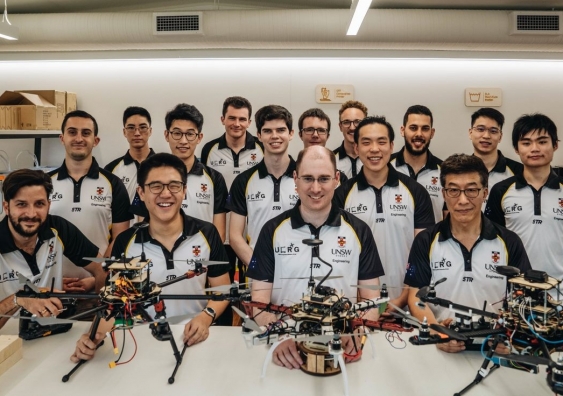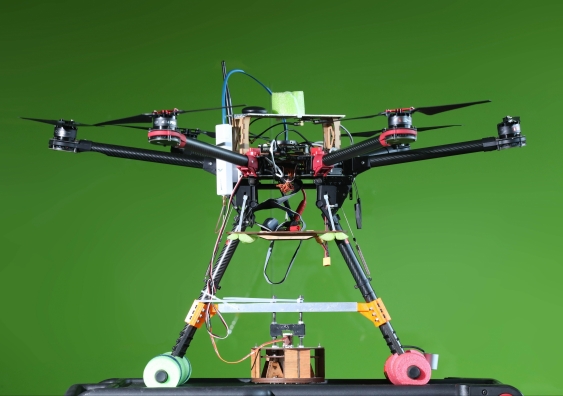UNSW Sydney students to represent Australia at $7m robotics comp
Students will compete against the world's brightest minds in robotics.
Students will compete against the world's brightest minds in robotics.

Louise Templeton
Corporate Communications
+61 (0)413 495 994
louise.templeton@unsw.edu.au
UNSW Engineering students will leave Sydney this weekend to compete for a share in over $7 million in sponsorship and prize money, at the Mohamed Bin Zayed International Robotics Competition (MBZIRC). MBZIRC is the world’s richest robotics competition and will take place in Abu Dhabi 23-26 February.
MBZIRC aims to attract the world’s brightest minds in intelligent robotics and push technological boundaries and applications in this field. The event will focus on the role of robotics and artificial intelligence in “smart city” solutions, and include construction and fire-fighting challenges.
Dylan Sanusi-Goh is a third-year mechatronics engineering student and operations manager for the UNSW Competitive Robotics team attending MBZIRC. He says the greatest challenge in preparing for the competition is managing the sheer complexity of tasks involved to get multiple autonomous vehicles to interact to achieve a goal.
“We have to program our vehicles to see their environment, understand it and take actions as a result - with no human intervention,” Mr Sanusi-Goh says.
The students are taking three unmanned aerial vehicles (UAVs, aka drones) and one unmanned ground vehicle (UGV) to compete in two of the competition’s four challenges. They must code the robots to interpret colour, patterns and variable temperatures, then act accordingly.
The first challenge will require the UAVs and UGVs to locate, select, transport and assemble different types of bricks to build predefined structures in an outdoor environment, to simulate autonomous building construction. The second requires the robots to work together to autonomously assess and extinguish a series of simulated fires in an urban high-rise firefighting scenario.
Senior lecturer in mechatronics Dr Mark Whitty says the competition provides tremendous exposure to the latest robotics research for UNSW students.
“To compete at MBZIRC, students have to produce highly sophisticated software programming,” Dr Whitty says.
“The competition will focus on multiple air and ground vehicles programmed to work together in given scenarios. Participation in the event gives the students excellent hands-on, practical experience in a highly competitive environment.”
Dr Whitty says the scope of challenges in the 2020 competition has dramatically increased since MBZIRC was first held in 2017.
“The tasks back then involved straightforward technical manoeuvres, like picking up objects and placing them in another spot. This year, the exercises are more focused on real-world applications and the requirement for collaborative operations between multiple air and ground vehicles,” he says.
“Dealing with real flames in a multi-storey building is hard enough for human firefighters, let alone autonomous robots. However, computing and sensing technology advancements, along with the availability of cost-effective, off-the-shelf drones, have simplified the hardware we use, so the teams can focus on creating the best software."

An example of a drone the UNSW team will take to Abu Dhabi
Mr Sanusi-Goh says the practical experience he has gained from his involvement with the competitive robotics group at UNSW Engineering has given him fantastic insights into what a robotics career might involve.
“A lot of students go through the coursework, not knowing what kind of jobs they can do once they’re through university. But hearing about these competitions, and students solving these challenges, provides really good awareness about the types of jobs that can transpire from an engineering degree.”
The UNSW team was the only all-Australian team to qualify for the competition, where 31 teams will compete from universities from 18 countries. In total, 68 teams tried out. The UNSW team is expected to be the only team made up of undergraduate students; most of their competitors will be PhD students and higher degree researchers.
Mr Sanusi-Goh is not fazed by this.
“Our academic supervisors have been super-supportive, and we also have some former students acting as our industry mentors to help us prepare for Abu Dhabi,” he says.
“Getting this level of exposure and experience at an undergraduate level is phenomenal.”
The UNSW Competitive Robotics team members for MBZIRC 2020:
Lancelot Chen, 25, Mechatronics Engineering Hideyoshi Cheong, 23, Electrical Engineering Scott Fraser, 24, Mechatronics Engineering James Horsley, 24, Mechanical Engineering Sharif Issa, 27 , Mechanical Engineering Mr Henry Phung, 22, Computer Science and Mechatronics Engineering Mr Benjamin Rigby, 22, Computer Science Engineering Mr Dylan Sanusi-Goh, 19, Computer Science and Mechatronics Engineering Mr Michael Xu, 24, Aerospace and Materials Science Engineering